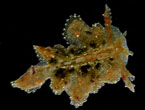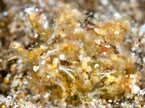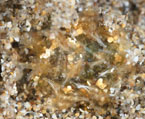| Home |
| Acknowledgments |
| Conventions |
| Glossary |
| Maps |
| References |
| Links |
| Articles |
| Thumbnails |
| Species
list |
| Family |
| Next
species |
Additional Photos

top

underside

cerata

red patches

without red

young, 4 mm

young, 7 mm

burying

Polybranchia cf. jannae Madrano, Krug, Gosliner, Kumar & Valdes, 2018

| Maximum size: about 64 mm. Identification: This species has broad, leaf-like, tuberculate cerata with serrated edges. The tubercles are tipped with white and irregular networks of fine white lines ascend the cerata. The cerata contain small, granular subapical masses and some have patches of brick-red pigment, irregular black patches and/or diffuse white medial patches. The marginal serrations contain faintly iridescent violet to clear spots. The rhinophores are translucent-cream with golden brown and red patches. Brick-red patches may also be present on the notum and there may be an opaque-white patch on the pericardium. In mature animals the irregular black patches on the cerata may become more numerous, the white lines on the cerata may be lost and numerous purple spots may develop (particularly along the edges of the cerata). The rhinophores are slender and the foot, at least in mature animals, ends in a long "tail" filament. Natural history: Polybranchia cf. jannae is known from four animals. The 7 mm juvenile was found crawling on sand-saturated algal turf during the day at a depth of 4 m (12 ft) at a moderately exposed site. The 4 mm juvenile was found in an algae wash taken at about 16 m (53 ft). The large, mature animal was found in an aquaculture tank on the Big Island in association with Caulerpa lentillifera. The animal without red patches was found at a depth of 1-3 m (3-7 ft) at a moderately protected site. It may feed on Caulerpa lentillifera (and relatives?). Distribution: Big Island and Maui: may be known from the western Pacific. Taxonomic notes: This species is similar to some animals assigned to Polybranchia jannae from the western Pacific. However, the match is imperfect so we're treating the ID as tentative pending more material. Similar animals from elsewhere can be seen at Lazy Diving and Sea Slug World. It was first recorded in Hawaii from Hekili Point, Maui by CP on March 29, 2014. Photo: Pam Madden: side; about 64 mm: found by Sarah Milisen on Caulerpa lentillifera in sea tank at NELHA, Kona, Big Island; Jan. 11, 2022. Observations and comments: Note 1: ( ) |
| Thumbnails |
Species
list |
Family | Next species | Top |